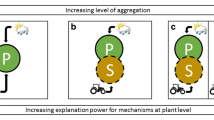Abstract
Nitrogen retranslocation from senescing leaves represents a crucial adaptation by tree species towards a more efficient use of this nutrient. As a result, this part of the nitrogen cycle has received increasing attention in recent years. However, there remain strong discrepancies with respect to the factors responsible for interspecific differences in the efficiency of this process.
In the present work the seasonal pattern of leaf growth and the movement of nitrogen in leaves have been studied in a series of Quercus ilex plots with different levels of rainfall and soil quality in central-western Spain, as well as in 20 other woody species typical of this area. The percentage of nitrogen retranslocated was estimated from the difference between the maximum mass of nitrogen stored in the leaf biomass and the amount of this nutrient returned annually to the soil through leaf fall.
Q. ilex appears as one of the least efficient species in the Mediterranean region in the recovery of nitrogen from senescing leaves (29.7% of the maximum pool). Furthermore, the older leaves of Q. ilex do not show the cycles of nitrogen withdrawal during new flushes of shoot growth, such as occurs in Pinus spp. This suggests that older leaves in Q. ilex do not play an important role as nitrogen storage organs.
Similar content being viewed by others

References
Bremner, J. M. 1960. Determination of nitrogen in soil by the Kjeldahl method. J. Agric. Sci. 55: 11–31.
Chabot, B. F. & Hicks, D. J. 1982. The ecology of leaf life spans. Ann. Rev. Ecol. Syst. 13: 229–259.
Chapin, F. S. & Kedrowski, R. A. 1983. Seasonal changes in nitrogen and phosphorus fractions and autumn retranslocation in evergreen and deciduous taiga trees. Ecology 64: 376–391.
Chapmann, H. D. & Pratt, P. F. 1973. Methods of analysis for soils, plants and waters. University of California Press. Riverside, California.
Deevey, E. S. 1947. Life tables for natural populations of animals. Quart. Rev. Biol. 22: 283–314.
Del, Arco, J. M., Escudero, A. & Garrido, M. V. 1991. Effects of site characteristics on nitrogen retranslocation from senescing leaves. Ecology 72: 701–708.
Escudero, A., Garcia, B., Gomez, J. M. & Luis, E. 1985. The nutrient cycling in Quercus rotundifolia Lam. and Quercus pyrenaica Willd. ecosystems (‘dehesas’) of Spain. Oecol. Plant. 6: 173–186.
Escudero, A., Manzano, J. J. & Del, Arco, J. M. 1987. Nitrogen concentrations in the leaves of different Mediterranean woody species. Ecologia Mediterranea 13: 11–17.
Fife, D. N. Nambiar, E. K. S. 1984. Accumulation and retranslocation of mineral nutrients in developing needles in relation to seasonal growth of young radiata pine trees. Ann. Bot. 50: 817–829.
Harper, J. L. 1977. Population biology of plants. Academic Press. London-New York-San Francisco.
Kummerow, J. 1983. Comparative phenology of mediterranean-type plant communities. In: Kruger, F. J., Michell, D. T. & Jarvis, J. U. M. (eds.). Mediterranean-type ecosystems. The role of nutrients. Springer-Verlag, Heidelberg.
Lajtha, K. & Whitford, W. G. 1989. The effect of water and nitrogen amendments on photosynthesis, leaf demography and resource-use efficiency in Larrea tridentata, a desert evergreen shrub. Oecologia 80: 341–348.
Landsberg, J. J. 1986. Physiological ecology of forest production. Academic Press, London.
Monk, C. D. 1966. An ecological significance of evergreenness. Ecology 47: 504–505.
Mooney, H. A. 1983. Carbon-gaining capacity and allocation patterns of mediterranean-climate plants. In: F. J., Kruger, Michell, D. T. & Jarvis, J. U. M. (eds.). Mediterraneantype ecosystems. The role of nutrients. Springer-Verlag, Heidelberg.
Nátr, L. 1975. Influence of mineral nutrition on photosynthesis and the use of assimilates. In: Cooper, J. P. (ed.). Photosynthesis and productivity in different environments. Cambridge University Press, Cambridge.
Rapp, M. 1969. Production de litière et apport ai sol d'éléments minéraux dans deux écosystèmes méditerranéens: la forêt de Quercus ilex L. et la garrigue de Quercus coccifera L. Oecol. Plant. 4: 377–410.
Ryan, D. F. & Bormann, F. H. 1982. Nutrient resorption in northern hardwood forests. Bio Science 32: 29–32.
Vitousek, P. 1982. Nutrient cycling and nutrient use efficiency. Am. Nat. 119: 553–572.
Walkley, A. & Black, I. A. 1934. An examination of the Degtjareff method for determining soil organic matter and a proposed modification of the chromic acid titration method. Soil Sci. 37: 29–38.
White, J. 1979. The plant as a metapopulation. Ann. Rev. Ecol. Syst. 10: 109–145.
Author information
Authors and Affiliations
Rights and permissions
About this article
Cite this article
Escudero, A., Del Arco, J.M. & Garrido, M.V. The efficiency of nitrogen retranslocation from leaf biomass in Quercus ilex ecosystems. Vegetatio 99, 225–237 (1992). https://doi.org/10.1007/BF00118229
Accepted:
Issue Date:
DOI: https://doi.org/10.1007/BF00118229



